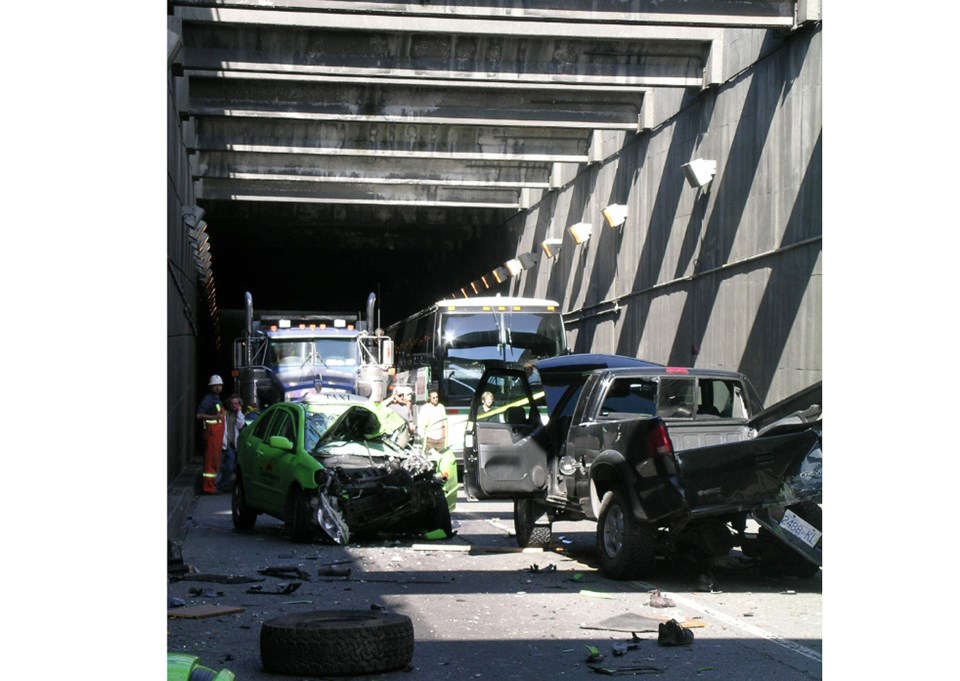It’s sadly another reason why the aging George Massey Tunnel needs to be replaced sooner rather than later.
Delta South MLA Ian Paton has that to say following yesterday’s horrific head-on crash which claimed the life of a Richmond woman, noting traffic safety concerns when it comes to the structure should compel a replacement structure as soon as possible.
The province is currently preparing a business case on a preferred replacement option – a new eight-lane immersed tunnel or a long-span bridge with the same number of lanes – to be completed later this year.
Paton noted that while the province is now undertaking upgrades to the current four-lane crossing, it’s far too difficult to make the tunnel much safer, especially when the counter-flow is in effect.
“When you have an accident or fire in the tunnel, our first responders have a heck of a time trying to get in there to attend that scene because of the narrowness of the tunnel. When this happens, it closes the tunnel down for hours or a day sometimes, depending on how bad the accident could be. This morning (Sept. 2) was a typical example,” said Paton.
“The counter-flow is another thing that’s a bit scary when you go through there at 80-kilometres-an-hour and you have cars or trucks coming at you literally a few feet away going the opposite direction. When I was on (Delta) city council, we discussed this for years and there was so much stakeholder consultations,” he said.
Noting the previous bridge project cancelled by the New Democrat government would have been just over a year away from completion by now, Paton said the $40 million now being spent on upgrades to the current crossing can’t change its width, size or traffic congestion.
A City of Delta report three years ago noted that not only is there a higher than average accident rate at the current tunnel, vehicular accidents in tunnel also tend to be more severe and result in more significant injuries and deaths than accidents on open roads.
A review of ICBC crashes from 2009 to 2013 found an average of more than 197 collisions annually at the tunnel and adjacent interchange, the report notes.
Of these, approximately 40 per cent resulted in casualties (injury or death).
Based on data from the Port Mann Bridge, a bridge would reduce collision rates by more than 35 per cent, the report adds.
Also citing concerns regarding first responder safety if there is a fire in the tunnel, the report notes accidents in and approaching the tunnel exacerbate an already heavily congested traffic situation.
That traffic and the lack of a shoulder lane for emergency vehicles make it difficult for first responders to reach and clear accidents, a situation which often creates an unacceptable delay in response times and the provision of critical care.
In a 2016 submission to the province, the city noted many accidents occur on the approach to the tunnel, since drivers tend to reduce speed and move away from the side wall when entering a confined space.
In combination with merging lanes, high traffic volumes and vehicles in close proximity, there is a higher likelihood of an accident. It’s especially problematic when the counter-flow is used during peak hours and traffic is going in both directions through a single tunnel.
According to transportation ministry representatives at an open house in Tsawwassen earlier this year, a bridge project would have a one-to-two year environmental review and require five years for construction.
A tunnel project would have an estimated three-year environmental review and require five years of construction. Both options include decommissioning the current tunnel.
The Greater Vancouver Board of Trade this week released a report with economic recovery recommendations which included speeding up the tunnel replacement.
It echoed a recent report issued by the B.C. Chamber of Commerce. The policy was submitted by the Delta Chamber of Commerce and endorsed by the other B.C. Chambers at their annual general meeting.



